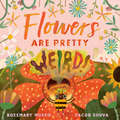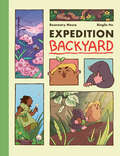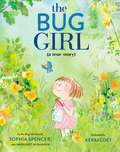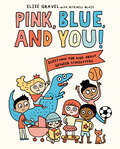Service Alert
CD service concludes July 31, 2025
CELA's audiobooks and magazines are available in Direct to Player and downloadable formats. We no longer mail out CDs. Please contact us for more information.
CELA's audiobooks and magazines are available in Direct to Player and downloadable formats. We no longer mail out CDs. Please contact us for more information.
Showing 1 - 13 of 13 items

By Rina Singh, Marianne Ferrer. 2020
A boy grows up to make positive change in his community. After suffering much heartache, Sundar decides change must come…
to his small Indian village. He believes girls should be valued as much as boys and that land should not be needlessly destroyed. Sundar's plan? To celebrate the birth of every girl with the planting of 111 trees. Though many villagers resist at first, Sundar slowly gains their support, and today, over a quarter of a million trees grow in his village. A once barren, deforested landscape has become a fertile, prosperous one where girls can thrive. Sure to plant seeds of hope in children. Improving the world is within everyone's reach.
By Helaine Becker. 2021
A fun introduction to prehistoric creatures that are not dinosaurs, and why! Everyone knows what a dinosaur is, right? Well,…
maybe not. Dinosaurs are actually just one type of extinct animal from prehistoric times. So, what sets them apart? Here, readers are introduced to ten prehistoric animals. Each one looks like a dinosaur. But it's missing at least one key characteristic of all true dinosaurs. Animal by animal, each of those characteristics is added to a growing list, until, by the end of the book, readers know just what makes a dinosaur a dinosaur! A dinosaur by any other name is . . . not a dinosaur, of course!
By Elise Gravel, Mykaell Blais. 2022
Simple, accessible, and direct, this picture book is perfect for kids and parents or teachers to read together, opening the…
door to conversations about gender stereotypes and everyone's right to be their true selves. Is it okay for boys to cry? Can girls be strong? Should girls and boys be given different toys to play with and different clothes to wear? Should we all feel free to love whoever we choose to love? In this incredibly kid-friendly and easy-to-grasp picture book, author-illustrator Elise Gravel and transgender collaborator Mykaell Blais raise these questions and others relating to gender roles, acceptance, and stereotyping.With its simple language, colorful illustrations, engaging backmatter that showcases how "appropriate" male and female fashion has changed through history, and even a poster kids can hang on their wall, here is the ideal tool to help in conversations about a multi-layered and important topic.
By Laura Alary, Andrea Blinick. 2022
In simple but expressive language, a mother describes to her young daughter how the sun’s light becomes the energy in…
her body through the oats, blueberries, and milk in her home-cooked breakfast.
By Eldon Yellowhorn, Kathy Lowinger. 2022
From healing to astronomy to our connection to the natural world, the lessons from Indigenous knowledge inform our learning and…
practices today. How do knowledge systems get passed down over generations? Through the knowledge inherited from their Elders and ancestors, Indigenous Peoples throughout North America have observed, practiced, experimented, and interacted with plants, animals, the sky, and the waters over millennia. Knowledge keepers have shared their wisdom with younger people through oral history, stories, ceremonies, and records that took many forms. In Sky Wolf's Call , award-winning author team of Eldon Yellowhorn and Kathy Lowinger reveal how Indigenous knowledge comes from centuries of practices, experiences, and ideas gathered by people who have a long history with the natural world. Indigenous knowledge is explored through the use of fire and water, the acquisition of food, the study of astronomy, and healing practices. *A Junior Library Guild Gold Standard Selection
By Kira Vermond, Suharu Ogawa. 2021
Science starts with a question in this fascinating compendium for curious kids. The team behind the acclaimed Why Don’t Cars…
Run on Apple Juice? is back to tackle more kid questions like “Are birds really dinosaurs?” and “Why do we have butts?” With help from Ontario Science Centre experts, Kira Vermond packs mind-boggling facts into answers that encourage further inquiry, covering topics over five sections: animals, the human body, planet Earth, tech and innovation, and outer space. From glowing scorpions and prehistoric sharks to stem cells and Mars missions, Suharu Ogawa’s colorful, zesty illustrations enhance Vermond’s lively tone.
By Craig Caudill, Carrie Shryock. 2022
"Meet two young adventurers as they discover the ancient art of reading outdoor clues. Join them as they learn to…
read a full moon, decode the colour of the ocean and forecast the weather with a rainbow, uncovering the secret signs of nature and a world of forgotten skills." -- Provided by publisher
By Eldon Yellowhorn, Kathy Lowinger. 2022
From healing to astronomy to our connection to the natural world, the lessons from Indigenous knowledge inform our learning and…
practices today. How do knowledge systems get passed down over generations? Through the knowledge inherited from their Elders and ancestors, Indigenous Peoples throughout North America have observed, practiced, experimented, and interacted with plants, animals, the sky, and the waters over millennia. Knowledge keepers have shared their wisdom with younger people through oral history, stories, ceremonies, and records that took many forms. In Sky Wolf’s Call, award-winning author team of Eldon Yellowhorn and Kathy Lowinger reveal how Indigenous knowledge comes from centuries of practices, experiences, and ideas gathered by people who have a long history with the natural world. Indigenous knowledge is explored through the use of fire and water, the acquisition of food, the study of astronomy, and healing practices. *A Junior Library Guild Gold Standard Selection
By Rosemary Mosco. 2022
Warning -- this book contains top-secret information about flowers! Prepare to be shocked and weirded out by this hilarious and…
totally true picture book introduction to some of nature's strangest plants.Flowers are beautiful. They have bright colors, soft petals and sweet nectar. Yum! But that's not the whole truth. Flowers can be WEIRD . . . and one bee is here to let everyone know! Talking directly to the reader, a bee reveals how flowers are so much stranger than what we think. Did you know that there are some flowers that only bloom in the nighttime? Some flowers are spooky, and look like ghosts, or bats, or a monster's mouth. And while most flowers smell good, there are some that smell like dead meat, or even horse poop! This hilarious and refreshing book with silly and sweet illustrations explores the science of flowers and shows that these plants are not always stereotypically pretty and harmless as we often think they are -- they are fascinating, disgusting, complicated and amazing.
By Rosemary Mosco, Binglin Hu. 2022
Join two best friends—a mole and vole—on their everyday expeditions to find beautiful plants, meet new animals, and learn more…
about the world all around them in this nonfiction graphic novel.Each day, Mole and Vole venture out into the world – never forgetting their nature journal! – to see what they can find in their own backyard. From pigeons and jumping spiders to swamp milkweed and maple trees, these two explorers get to know every part of their local environment. But after an accidental move from the country to the city, Mole and Vole worry that everything will be different. As they explore, they discover plants to look at and animals to meet in their new home as well. The story of these two best friends brings to life a nonfiction adventure of finding wonder in nature everywhere – no matter where you live. This book concludes with fun activities for kids to do at home.
By Margaret McNamara, Sophia Spencer. 2020
7-year-old Sophia Spencer was bullied for loving bugs until hundreds of women scientists rallied around her. Now Sophie tells her…
inspiring story in this picture book that celebrates women in science, bugs of all kinds and the importance of staying true to yourself.Sophia Spencer has loved bugs ever since a butterfly landed on her shoulder--and wouldn't leave!--at a butterfly conservancy when she was only two-and-a-half years old. In preschool and kindergarten, Sophia was thrilled to share what she knew about grasshoppers (her very favorite insects), as well as ants and fireflies . . . but by first grade, not everyone shared her enthusiasm. Some students bullied her, and Sophia stopped talking about bugs altogether. When Sophia's mother wrote to an entomological society looking for a bug scientist to be a pen pal for her daughter, she and Sophie were overwhelmed by the enthusiastic response--letters, photos and videos came flooding in. Using the hashtag BugsR4Girls, scientists tweeted hundreds of times to tell Sophia to keep up her interest in bugs--and it worked!
By Elise Gravel, Mykaell Blais. 2022
Simple, accessible, and direct, this picture book is perfect for kids and parents or teachers to read together, opening the…
door to conversations about gender stereotypes and everyone's right to be their true selves. Is it okay for boys to cry? Can girls be strong? Should girls and boys be given different toys to play with and different clothes to wear? Should we all feel free to love whoever we choose to love? In this incredibly kid-friendly and easy-to-grasp picture book, author-illustrator Elise Gravel and transgender collaborator Mykaell Blais raise these questions and others relating to gender roles, acceptance, and stereotyping.With its simple language, colorful illustrations, engaging backmatter that showcases how "appropriate" male and female fashion has changed through history, and even a poster kids can hang on their wall, here is the ideal tool to help in conversations about a multi-layered and important topic.
By Jess Keating. 2021
Go big or go home! Meet the biggest weirdos on Earth in this colosally cool collection from the team that…
brought you Pink Is For Blobfish.It's a big wide world, full of critters that are larger than life! Sure, there are the usual suspects: blue whales, polar bears, elephant seals . . . but others will take you by surprise. The giant snail, for instance, or the ginormous Atlas moth. Like Pink Is for Blobfish and Cute as an Axolotl, Big as a Giant Snail will cover a wide variety of species, while subtly delving into misconceptions and stereotypes associated with size. Best of all? These tall tales are totally true! "Awe-inspiring... This work fits into so many lessons, from endangered species to climate change and habitat preservation, that it&’s hard to imagine a collection that would not benefit from having it on its shelves." —School Library Journal